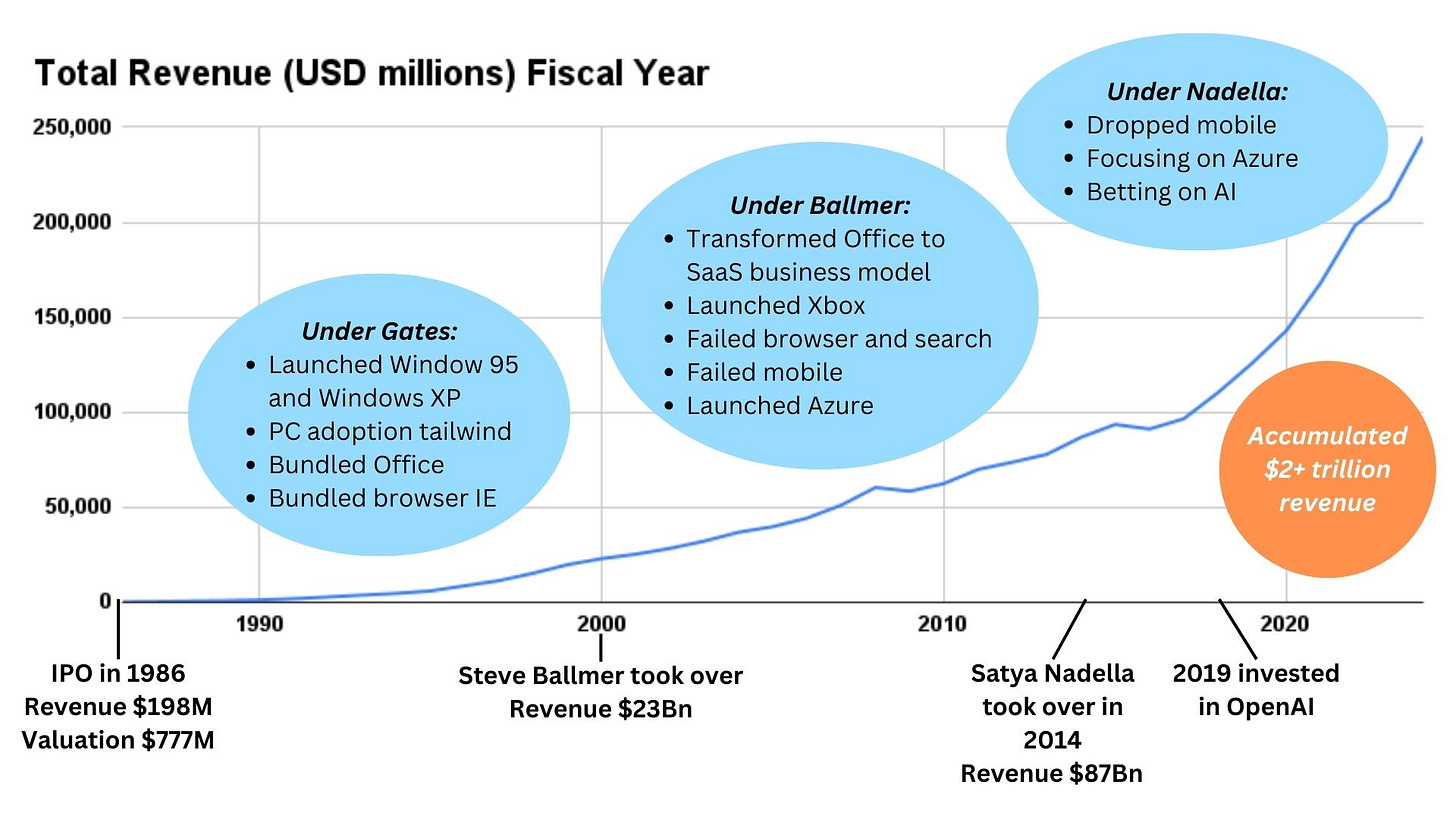Microsoft is 50 years old. That’s really old in technology years.
As most boomers, Gen-X, and millennials who grew up with Microsoft, Microsoft was a single product company started with MS DOS (Microsoft Disk Operating System).
Contrary to common belief, Microsoft DOS was the first widely adopted operating system, not Apple’s. Windows 95 was built on top of DOS with a Graphic User Interface (GUI), which was developed by Xerox PARC.
“When Steve Jobs accused Bill Gates of stealing from Apple, Gates said, “Well, Steve, I think there’s more than one way of looking at it. I think it’s more like we both had this rich neighbor named Xerox and I broke into his house to steal the TV set and found out that you had already stolen it.”
Did Microsoft steal Apple’s GUI design? Maybe. It doesn’t matter. Thanks to its partnership with IBM, Microsoft’s early success came from distribution. More importantly, Bill Gates didn’t grant IBM exclusivity, which made it possible to do business with the IBM clones.
When IBM shipped millions of PCs worldwide, Microsoft followed suit, selling millions of copies of Windows. Then, IBM clone PCs like Compaq started to take off. Windows was distributed through these OEMs. At the same time, Intel’s X86 chip was powering these PCs, on which Windows is built and optimized. Hence, the duo Wintel dominated the PC era.
This is the Wintel flywheel: the wider the distribution of Windows, the more users adopt it; the more users there are, the more software is developed for Windows and optimized for Intel chips—driving even more users to choose Windows PCs powered by Intel.
Windows XP, at its peak, had 76% of the market share. The default wallpaper was iconic.
In addition to Windows, Microsoft developed Excel in 1985 (initially for Macintosh) and acquired PowerPoint in 1987. In 1989, Microsoft Word was available on Windows. In 1990, Microsoft officially bundled Word, Excel, and Powerpoint in Microsoft Office, which became the second largest revenue generation product during the late PC era (1990 to 2007).
Bill Gates handed the reign of Microsoft over to Steve Ballmer in 2000. Ballmer was a world-class number two and excellent at sales. Ballmer more than doubled the company's revenue from 2000 to 2007. It worked to have a sales CEO pushing the existing products’ potential to the maximum.
However, the first iPhone, launched in 2007, changed everything. The iPhone with iOS was the first smartphone with a touchscreen. In 2008, the Apple App Store was launched, and the mobile computing era started.
Famously, Ballmer laughed at the first iPhone, which was priced at 500 USD and didn’t have a keyboard for business users. “I like our strategy”, concluded Ballmer.
What Ballmer didn’t get is that mobile is a paradigm shift. You cannot just twist Windows and put it on the phone. You need to rebuild a new operation system just for the phone, adapted to the form factor and power constraint, and source the chip that is designed and built for it. Wintel (both Windows and Intel) lost the mobile wave.
Redesign and rebuild the whole thing. That’s what Apple did. That’s why Microsoft / Ballmer lost mobile.
One year before the first iPhone launch, AWS was launched by Amazon. This kicked off the cloud computing era. Contrary to the common perception, it wasn’t Satya Nadella who launched Azure, Microsoft’s cloud product. It was Ballmer in 2010, 4 years before Nadella took over.
Ballmer got a lot of things right. Under his reign, Microsoft X4 its revenue. Ballmer was a world-class sales guy, pushing the revenue to record high with the existing product set by Bill Gates. Ballmer transformed Office to a SaaS business model and made it a cash machine. He launched Azure.
But he was not a tech visionary, neither a product guy. Microsoft lost the browser dominance while it had 90% of the market share at its peak. It also lost the search catch-up of Google. The most impactful miss was obviously mobile, which made Apple the 1st trillion USD company. In his last days as the CEO, Ballmer bought the Nokia Mobile Division for one last try in the mobile space. The Nokia acquisition was a big mistake. Famously, Ballmer also made Microsoft a very political place to work.
Despite not being a product guy, Ballmer picked a product person, Satya Nadella, who dropped mobile for good, ended the one Microsoft strategy, pivoted away from Windows, and caught up AWS as the close 2nd in the race. He bought LinkedIn and Github, which were very successful acquisitions. In 2019, Microsoft invested in OpenAI, which allowed them to get the insights of Generative AI before anybody else.
In 2024, Microsoft was back to its peak, competing with Apple on which one is the most valuable company in the world (if we exclude Nvidia for briefly taking the crown).
Microsoft is a phenomenal company that has created more than $2 trillion in revenue (economic value) since its creation.
They got a couple of things right during the 50 years:
Focused on distribution right from the beginning: partnered with IBM and then with IBM PC clones like Compaq
Bundled Word, Excel, and Powerpoint, creating the most successful productivity software in the history
Stayed true to its DNA as a platform company to let developers build on top
Transformed office to SaaS business model
Launched Azure and caught up in the race of cloud
Betted on AI at the right time (2019 before GPT 3)
Successful acquisitions: Powerpoint, Linkedin, Github
They got several things wrong:
Failed mobile and failed to understand Mobile was a paradigm shift
Failed browser while they had 90%+ market share
Failed search while attempting to catch up Google
Failed acquisitions: Skype, Nokia Mobile Division
Time and time again, Microsoft has demonstrated in tech: distribution > product
And CEOs really matter.
Recommended reading list about Microsoft:
Satya Nadella email to employees on first day as CEO






